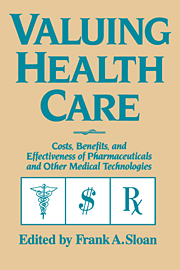 Valuing Health Care
Valuing Health Care Book contents
- Frontmatter
- Contents
- List of Tables
- List of Figures
- List of Boxes
- Acknowledgments
- 1 Introduction
- 2 Evidence of effectiveness: evaluating its quality
- 3 Utility assessment for estimating quality-adjusted life years
- 4 Measuring costs
- 5 From cost–effectiveness ratios to resource allocation: where to draw the line?
- 6 Valuing health care benefits in money terms
- 7 Discounting health effects for medical decisions
- 8 Statistical issues in cost–effectiveness analyses
- 9 Decision trees and Markov models in cost–effectiveness research
- 10 The use of cost–effectiveness/cost–benefit analysis in actual decision making: current status and prospects
- Notes
- References
- Index
9 - Decision trees and Markov models in cost–effectiveness research
Published online by Cambridge University Press: 07 December 2009
- Frontmatter
- Contents
- List of Tables
- List of Figures
- List of Boxes
- Acknowledgments
- 1 Introduction
- 2 Evidence of effectiveness: evaluating its quality
- 3 Utility assessment for estimating quality-adjusted life years
- 4 Measuring costs
- 5 From cost–effectiveness ratios to resource allocation: where to draw the line?
- 6 Valuing health care benefits in money terms
- 7 Discounting health effects for medical decisions
- 8 Statistical issues in cost–effectiveness analyses
- 9 Decision trees and Markov models in cost–effectiveness research
- 10 The use of cost–effectiveness/cost–benefit analysis in actual decision making: current status and prospects
- Notes
- References
- Index
Summary
This chapter shows how decision trees can be used to structure analyses of choices involving drug treatments. The choices can be either at the individual level of deciding which treatment is best for a particular patient or at the policymaking level of influencing how classes of patients are treated. Such policy choices are faced by insurers in deciding which treatments to cover, by quality reviewers, by managers or consensus panels of health maintenance organizations (HMOs) in deciding which treatment options to allow or promote for various classes of patients, and even by the U.S. Food and Drug Administration or its counterparts in other countries in deciding whether drugs are safe and effective for a particular use.
The chapter begins by showing how decision trees display the choices and uncertainties involved in diagnosis and treatment decisions. In this method, management alternatives are judged on the basis of the value of expected costs and health outcomes. Typical alternatives for treatment might be using the current standard drug versus using a new more expensive and more powerful drug. Typical diagnostic alternatives are deciding treatment immediately versus getting more information before deciding. Predicting the immediate outcomes of treatment is usually straightforward, but predicting long-run impacts can be more difficult.
Many models have been used to predict the long-run outcomes of treatment. The second half of the chapter discusses these models (in order of increasing complexity): formulas for life expectancy, Markov chains, Markov processes, and simulations.
Information
- Type
- Chapter
- Information
- Valuing Health CareCosts, Benefits, and Effectiveness of Pharmaceuticals and Other Medical Technologies, pp. 185 - 206Publisher: Cambridge University PressPrint publication year: 1995
Accessibility standard: Unknown
- 9
- Cited by